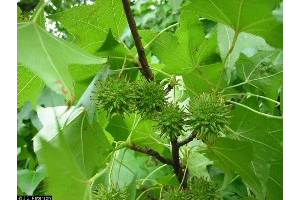Liquidambar styraciflua is used for pulp, fuel, and lumber; in cabinetry, home furnishings, furniture, boxes, crates, baskets and utensils, as well as railroad ties, fencing, plywood, and veneer. The plant was used medicinally. Its sap, once hardened, was used as a fragrant gum.
Photo Credit: © J.S. Peterson, USDA-NRCS PLANTS Database.
Liquidambar styraciflua
Common Name: sweetgum
Plant Functional Group: Deciduous broadleaf
Class > Order > Family: Magnoliopsida > Saxifragales > Altingiaceae
What does the species look like?
Sweetgum is a deciduous tree growing 50 to 130 feet tall or more and with a trunk up to 3 to feet in diameter. Trees begin flowering at maturity at about 20 to 30 years old. The male and female flowers occur separately on the same tree and are wind-pollinated.
Sweetgum grows in moist to wet woods, tidal swamps, swampy bottomlands, streambanks, clearings and old fields, and mesic upland forests and forest edges. It grows best on the rich, moist soils of river bottomlands.
Where is the species found?
States & Provinces
AL, AR, CA, CT, DC, DE, FL, GA, IL, IN, KY, LA, MA, MD, MO, MS, NC, NJ, NY, OH, OK, PA, RI, SC, TN, TX, VA, WV
Special Considerations for Observing
If drought seems to be the cause of leaf color or fall for a plant, please make a comment about it for that observation.
This species has separate male and female flowers. If you know whether the flowers you are observing are male or female (or both), please make a comment about it for that observation.
Which phenophases should I observe?
Do you see...?
Leaves
Breaking leaf buds More...
How many buds are breaking?
Less than 3 3 to 10 11 to 100 101 to 1,000 1,001 to 10,000 More than 10,000
Leaves More...
What percentage of the potential canopy space is full with leaves? Ignore dead branches in your estimate of potential canopy space.
Less than 5% 5-24% 25-49% 50-74% 75-94% 95% or more
Increasing leaf size More...
What percentage of full size are most leaves?
Less than 25% 25-49% 50-74% 75-94% 95% or more
Colored leaves More...
What percentage of the potential canopy space is full with non-green leaf color? Ignore dead branches in your estimate of potential canopy space.
Less than 5% 5-24% 25-49% 50-74% 75-94% 95% or more
Falling leaves More...
Flowers
Flowers or flower buds Liquidambar styraciflua , the male inflorescence is an erect cone with several round clusters of petal-less flowers that are initially compact, but eventually grow looser and fluffier. The female inflorescence is a small globe with petal-less flowers that hangs below the branch. Once the female flowers wilt, the globe will turn brighter green as the fruits develop.More...
How many flowers and flower buds are present? For species in which individual flowers are clustered in flower heads, spikes or catkins (inflorescences), simply estimate the number of flower heads, spikes or catkins and not the number of individual flowers.
Less than 3 3 to 10 11 to 100 101 to 1,000 1,001 to 10,000 More than 10,000
Open flowers Liquidambar styraciflua , the male flowers are open when the round clusters loosen, making the initially compact clusters appear fluffier. Female flowers are open when the pistils are visible, but will be difficult to see where they are out of reach.More...
What percentage of all fresh flowers (buds plus unopened plus open) on the plant are open? For species in which individual flowers are clustered in flower heads, spikes or catkins (inflorescences), estimate the percentage of all individual flowers that are open.
Less than 5% 5-24% 25-49% 50-74% 75-94% 95% or more
Fruits
Fruits Liquidambar styraciflua , the fruit is a spiny dense globe of capsules that changes from green to dark brown, with each tiny capsule splitting open to expose the seeds. Do not include balls of empty capsules that have already dropped all of their seeds.More...
How many fruits are present?
Less than 3 3 to 10 11 to 100 101 to 1,000 1,001 to 10,000 More than 10,000
Ripe fruits Liquidambar styraciflua , a fruit is considered ripe when it has turned dark brown and the capsules have begun to split open to expose the seeds. Do not include balls of empty capsules that have already dropped all of their seeds.More...
What percentage of all fruits (unripe plus ripe) on the plant are ripe?
Less than 5% 5-24% 25-49% 50-74% 75-94% 95% or more
Recent fruit or seed drop More...
How many mature fruits have dropped seeds or have completely dropped or been removed from the plant since your last visit?
Less than 3 3 to 10 11 to 100 101 to 1,000 1,001 to 10,000 More than 10,000
What do these phenophases look like?
There is currently no photoguide available for this species. If you'd like help us create one, use the guidance document and species template provided here . Then send it via email to education@usanpn.org when it is complete.
